Public Health Nutrition Report: Government Action on Unhealthy Food
VerifiedAdded on 2023/06/11
|10
|2849
|299
Report
AI Summary
This report delves into the critical issue of unhealthy food consumption and advocates for government intervention through taxation. It highlights the detrimental health effects of junk food, including obesity, heart complications, and cognitive impairments. The report summarizes advocacy activities, emphasizing the importance of price elasticity in reducing junk food consumption. It references Denmark's attempt at a fat tax and proposes strategies such as taxing specific nutrients, snack foods, and sugar-sweetened beverages. The report also suggests additional activities like demonstrations and community education programs to push the government to implement these taxes, ultimately aiming to improve public health by curbing the consumption of unhealthy foods.
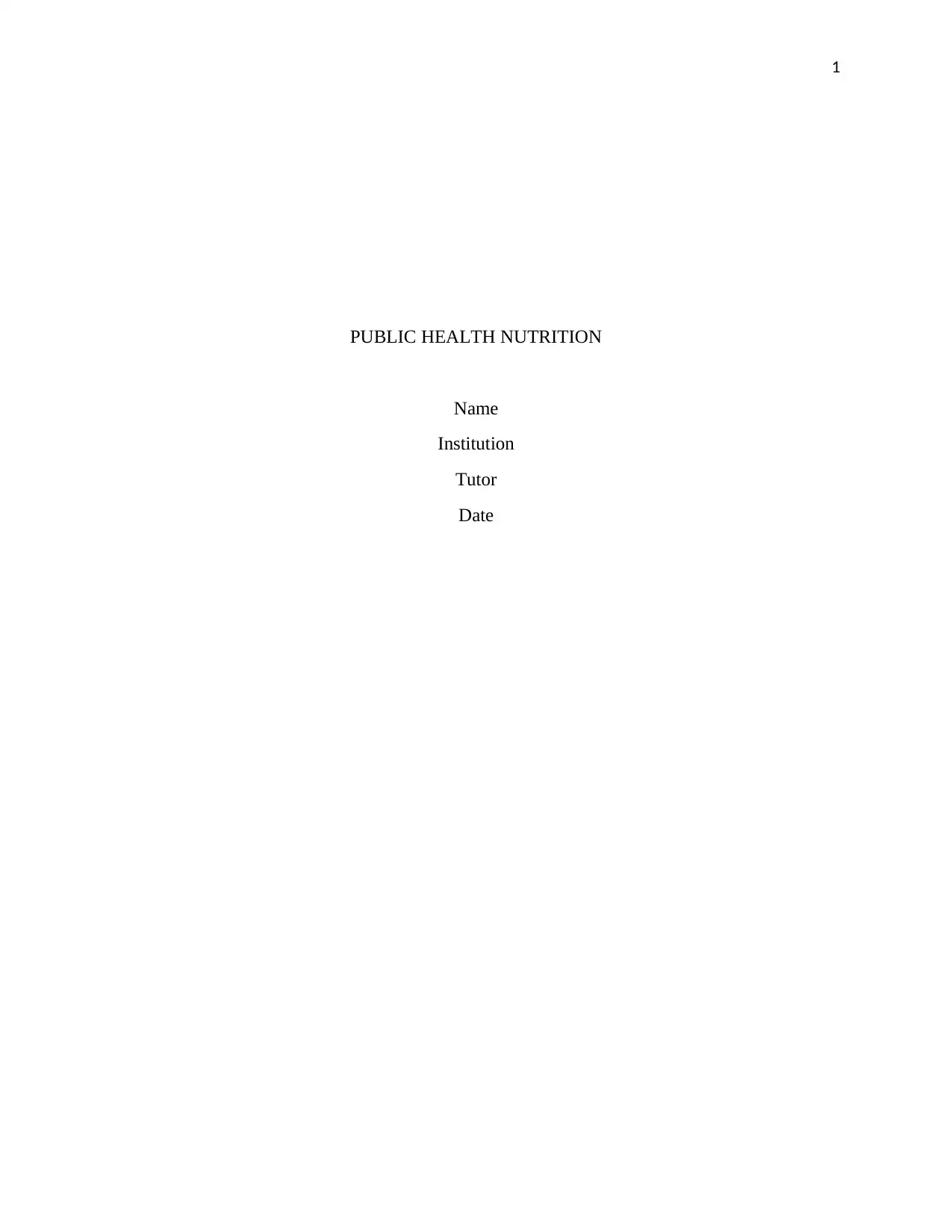
1
PUBLIC HEALTH NUTRITION
Name
Institution
Tutor
Date
PUBLIC HEALTH NUTRITION
Name
Institution
Tutor
Date
Paraphrase This Document
Need a fresh take? Get an instant paraphrase of this document with our AI Paraphraser
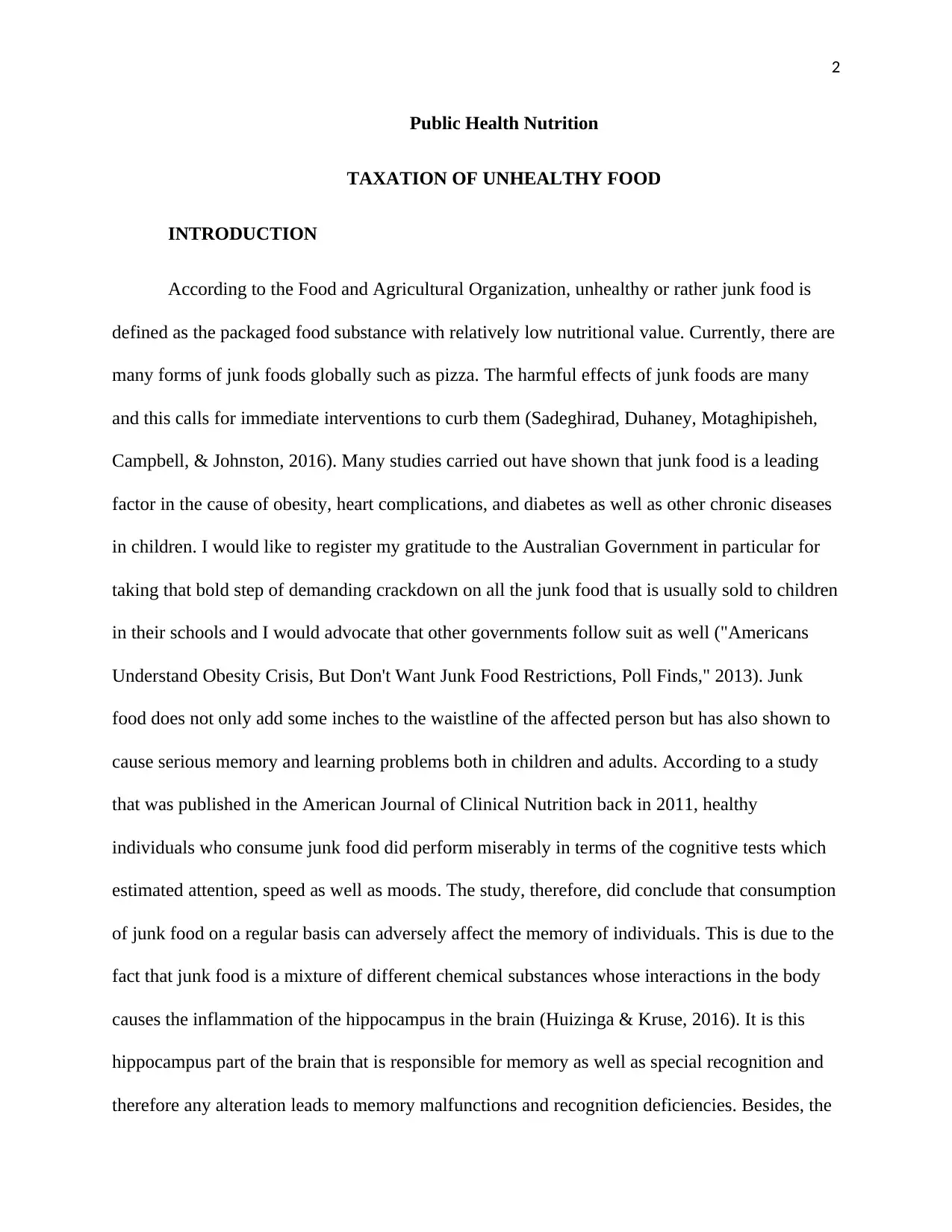
2
Public Health Nutrition
TAXATION OF UNHEALTHY FOOD
INTRODUCTION
According to the Food and Agricultural Organization, unhealthy or rather junk food is
defined as the packaged food substance with relatively low nutritional value. Currently, there are
many forms of junk foods globally such as pizza. The harmful effects of junk foods are many
and this calls for immediate interventions to curb them (Sadeghirad, Duhaney, Motaghipisheh,
Campbell, & Johnston, 2016). Many studies carried out have shown that junk food is a leading
factor in the cause of obesity, heart complications, and diabetes as well as other chronic diseases
in children. I would like to register my gratitude to the Australian Government in particular for
taking that bold step of demanding crackdown on all the junk food that is usually sold to children
in their schools and I would advocate that other governments follow suit as well ("Americans
Understand Obesity Crisis, But Don't Want Junk Food Restrictions, Poll Finds," 2013). Junk
food does not only add some inches to the waistline of the affected person but has also shown to
cause serious memory and learning problems both in children and adults. According to a study
that was published in the American Journal of Clinical Nutrition back in 2011, healthy
individuals who consume junk food did perform miserably in terms of the cognitive tests which
estimated attention, speed as well as moods. The study, therefore, did conclude that consumption
of junk food on a regular basis can adversely affect the memory of individuals. This is due to the
fact that junk food is a mixture of different chemical substances whose interactions in the body
causes the inflammation of the hippocampus in the brain (Huizinga & Kruse, 2016). It is this
hippocampus part of the brain that is responsible for memory as well as special recognition and
therefore any alteration leads to memory malfunctions and recognition deficiencies. Besides, the
Public Health Nutrition
TAXATION OF UNHEALTHY FOOD
INTRODUCTION
According to the Food and Agricultural Organization, unhealthy or rather junk food is
defined as the packaged food substance with relatively low nutritional value. Currently, there are
many forms of junk foods globally such as pizza. The harmful effects of junk foods are many
and this calls for immediate interventions to curb them (Sadeghirad, Duhaney, Motaghipisheh,
Campbell, & Johnston, 2016). Many studies carried out have shown that junk food is a leading
factor in the cause of obesity, heart complications, and diabetes as well as other chronic diseases
in children. I would like to register my gratitude to the Australian Government in particular for
taking that bold step of demanding crackdown on all the junk food that is usually sold to children
in their schools and I would advocate that other governments follow suit as well ("Americans
Understand Obesity Crisis, But Don't Want Junk Food Restrictions, Poll Finds," 2013). Junk
food does not only add some inches to the waistline of the affected person but has also shown to
cause serious memory and learning problems both in children and adults. According to a study
that was published in the American Journal of Clinical Nutrition back in 2011, healthy
individuals who consume junk food did perform miserably in terms of the cognitive tests which
estimated attention, speed as well as moods. The study, therefore, did conclude that consumption
of junk food on a regular basis can adversely affect the memory of individuals. This is due to the
fact that junk food is a mixture of different chemical substances whose interactions in the body
causes the inflammation of the hippocampus in the brain (Huizinga & Kruse, 2016). It is this
hippocampus part of the brain that is responsible for memory as well as special recognition and
therefore any alteration leads to memory malfunctions and recognition deficiencies. Besides, the
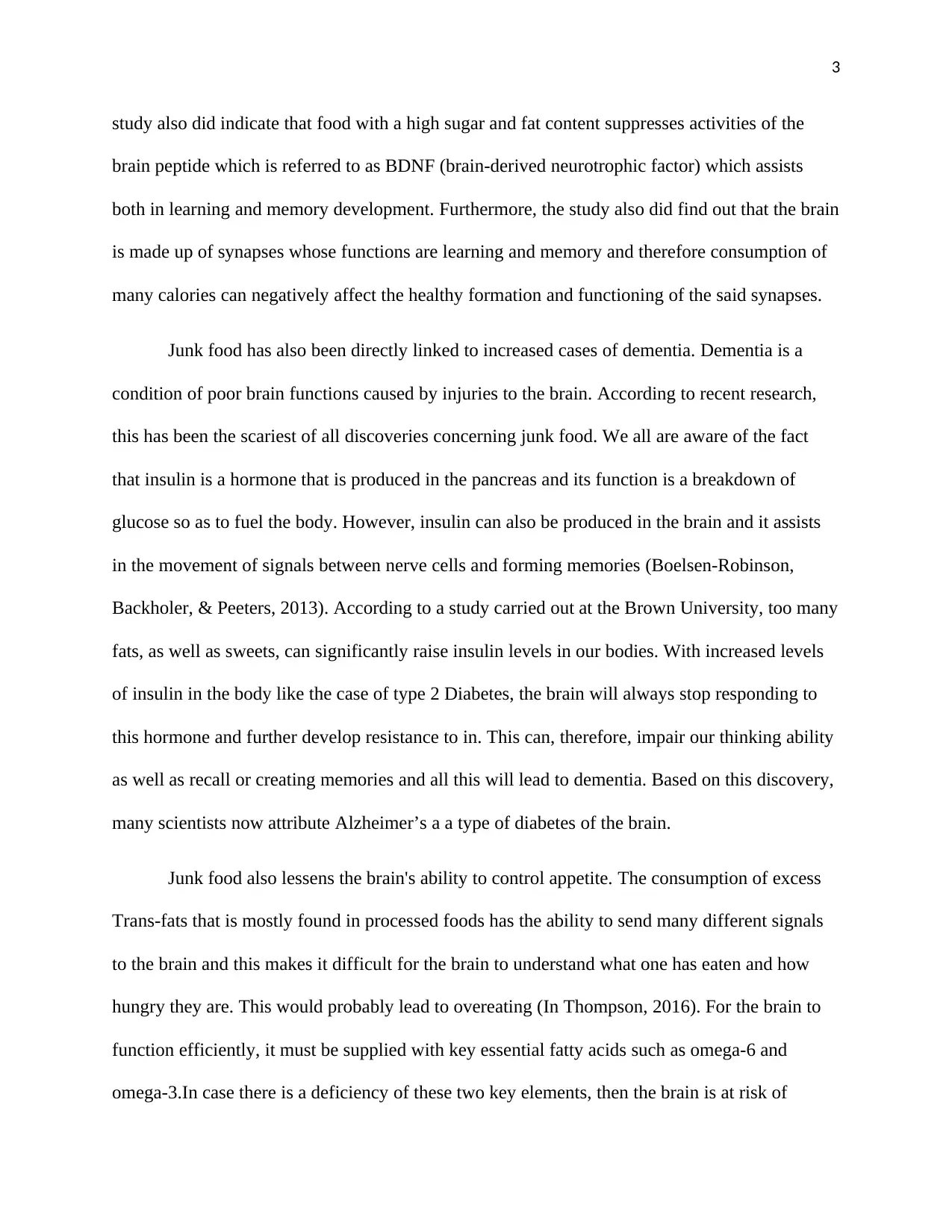
3
study also did indicate that food with a high sugar and fat content suppresses activities of the
brain peptide which is referred to as BDNF (brain-derived neurotrophic factor) which assists
both in learning and memory development. Furthermore, the study also did find out that the brain
is made up of synapses whose functions are learning and memory and therefore consumption of
many calories can negatively affect the healthy formation and functioning of the said synapses.
Junk food has also been directly linked to increased cases of dementia. Dementia is a
condition of poor brain functions caused by injuries to the brain. According to recent research,
this has been the scariest of all discoveries concerning junk food. We all are aware of the fact
that insulin is a hormone that is produced in the pancreas and its function is a breakdown of
glucose so as to fuel the body. However, insulin can also be produced in the brain and it assists
in the movement of signals between nerve cells and forming memories (Boelsen-Robinson,
Backholer, & Peeters, 2013). According to a study carried out at the Brown University, too many
fats, as well as sweets, can significantly raise insulin levels in our bodies. With increased levels
of insulin in the body like the case of type 2 Diabetes, the brain will always stop responding to
this hormone and further develop resistance to in. This can, therefore, impair our thinking ability
as well as recall or creating memories and all this will lead to dementia. Based on this discovery,
many scientists now attribute Alzheimer’s a a type of diabetes of the brain.
Junk food also lessens the brain's ability to control appetite. The consumption of excess
Trans-fats that is mostly found in processed foods has the ability to send many different signals
to the brain and this makes it difficult for the brain to understand what one has eaten and how
hungry they are. This would probably lead to overeating (In Thompson, 2016). For the brain to
function efficiently, it must be supplied with key essential fatty acids such as omega-6 and
omega-3.In case there is a deficiency of these two key elements, then the brain is at risk of
study also did indicate that food with a high sugar and fat content suppresses activities of the
brain peptide which is referred to as BDNF (brain-derived neurotrophic factor) which assists
both in learning and memory development. Furthermore, the study also did find out that the brain
is made up of synapses whose functions are learning and memory and therefore consumption of
many calories can negatively affect the healthy formation and functioning of the said synapses.
Junk food has also been directly linked to increased cases of dementia. Dementia is a
condition of poor brain functions caused by injuries to the brain. According to recent research,
this has been the scariest of all discoveries concerning junk food. We all are aware of the fact
that insulin is a hormone that is produced in the pancreas and its function is a breakdown of
glucose so as to fuel the body. However, insulin can also be produced in the brain and it assists
in the movement of signals between nerve cells and forming memories (Boelsen-Robinson,
Backholer, & Peeters, 2013). According to a study carried out at the Brown University, too many
fats, as well as sweets, can significantly raise insulin levels in our bodies. With increased levels
of insulin in the body like the case of type 2 Diabetes, the brain will always stop responding to
this hormone and further develop resistance to in. This can, therefore, impair our thinking ability
as well as recall or creating memories and all this will lead to dementia. Based on this discovery,
many scientists now attribute Alzheimer’s a a type of diabetes of the brain.
Junk food also lessens the brain's ability to control appetite. The consumption of excess
Trans-fats that is mostly found in processed foods has the ability to send many different signals
to the brain and this makes it difficult for the brain to understand what one has eaten and how
hungry they are. This would probably lead to overeating (In Thompson, 2016). For the brain to
function efficiently, it must be supplied with key essential fatty acids such as omega-6 and
omega-3.In case there is a deficiency of these two key elements, then the brain is at risk of
⊘ This is a preview!⊘
Do you want full access?
Subscribe today to unlock all pages.

Trusted by 1+ million students worldwide
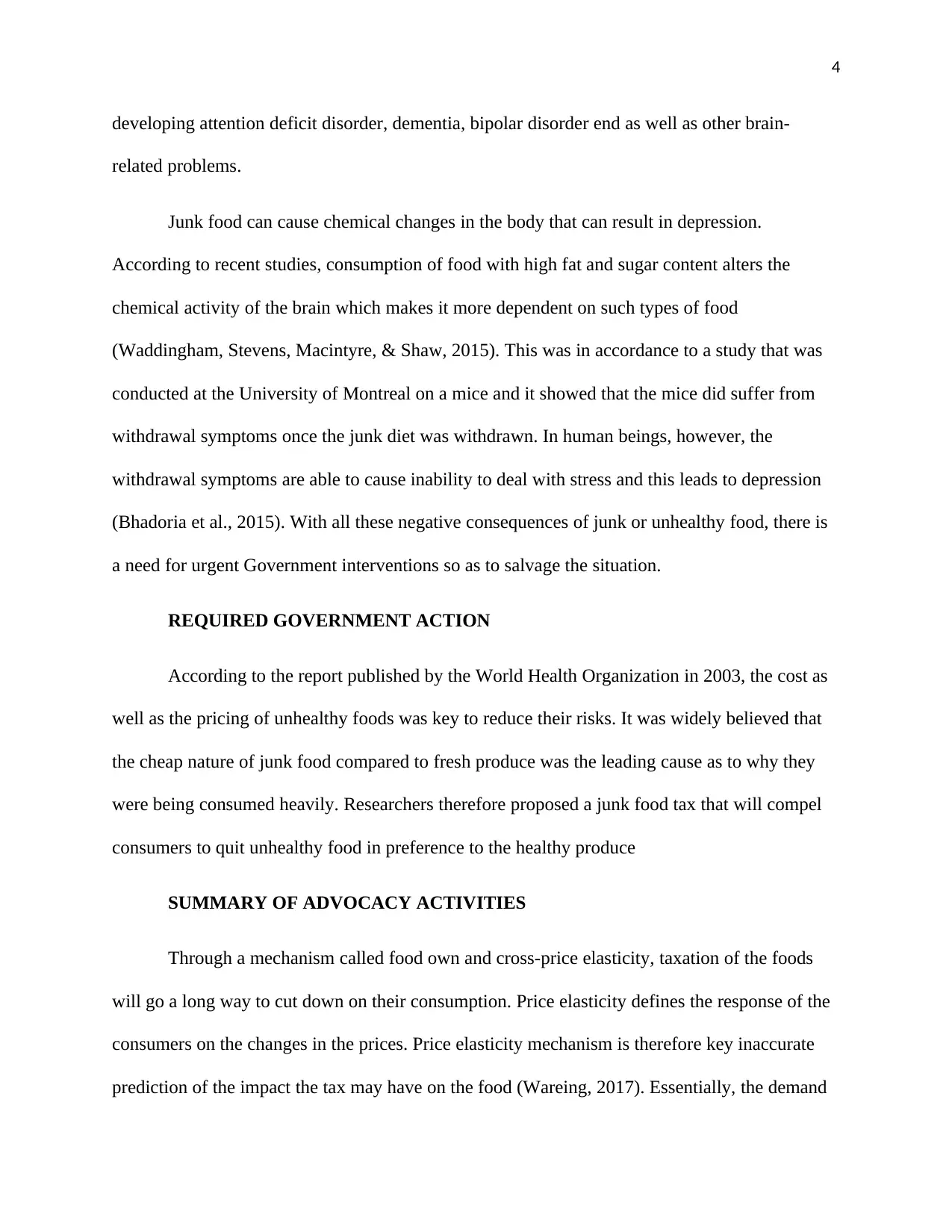
4
developing attention deficit disorder, dementia, bipolar disorder end as well as other brain-
related problems.
Junk food can cause chemical changes in the body that can result in depression.
According to recent studies, consumption of food with high fat and sugar content alters the
chemical activity of the brain which makes it more dependent on such types of food
(Waddingham, Stevens, Macintyre, & Shaw, 2015). This was in accordance to a study that was
conducted at the University of Montreal on a mice and it showed that the mice did suffer from
withdrawal symptoms once the junk diet was withdrawn. In human beings, however, the
withdrawal symptoms are able to cause inability to deal with stress and this leads to depression
(Bhadoria et al., 2015). With all these negative consequences of junk or unhealthy food, there is
a need for urgent Government interventions so as to salvage the situation.
REQUIRED GOVERNMENT ACTION
According to the report published by the World Health Organization in 2003, the cost as
well as the pricing of unhealthy foods was key to reduce their risks. It was widely believed that
the cheap nature of junk food compared to fresh produce was the leading cause as to why they
were being consumed heavily. Researchers therefore proposed a junk food tax that will compel
consumers to quit unhealthy food in preference to the healthy produce
SUMMARY OF ADVOCACY ACTIVITIES
Through a mechanism called food own and cross-price elasticity, taxation of the foods
will go a long way to cut down on their consumption. Price elasticity defines the response of the
consumers on the changes in the prices. Price elasticity mechanism is therefore key inaccurate
prediction of the impact the tax may have on the food (Wareing, 2017). Essentially, the demand
developing attention deficit disorder, dementia, bipolar disorder end as well as other brain-
related problems.
Junk food can cause chemical changes in the body that can result in depression.
According to recent studies, consumption of food with high fat and sugar content alters the
chemical activity of the brain which makes it more dependent on such types of food
(Waddingham, Stevens, Macintyre, & Shaw, 2015). This was in accordance to a study that was
conducted at the University of Montreal on a mice and it showed that the mice did suffer from
withdrawal symptoms once the junk diet was withdrawn. In human beings, however, the
withdrawal symptoms are able to cause inability to deal with stress and this leads to depression
(Bhadoria et al., 2015). With all these negative consequences of junk or unhealthy food, there is
a need for urgent Government interventions so as to salvage the situation.
REQUIRED GOVERNMENT ACTION
According to the report published by the World Health Organization in 2003, the cost as
well as the pricing of unhealthy foods was key to reduce their risks. It was widely believed that
the cheap nature of junk food compared to fresh produce was the leading cause as to why they
were being consumed heavily. Researchers therefore proposed a junk food tax that will compel
consumers to quit unhealthy food in preference to the healthy produce
SUMMARY OF ADVOCACY ACTIVITIES
Through a mechanism called food own and cross-price elasticity, taxation of the foods
will go a long way to cut down on their consumption. Price elasticity defines the response of the
consumers on the changes in the prices. Price elasticity mechanism is therefore key inaccurate
prediction of the impact the tax may have on the food (Wareing, 2017). Essentially, the demand
Paraphrase This Document
Need a fresh take? Get an instant paraphrase of this document with our AI Paraphraser
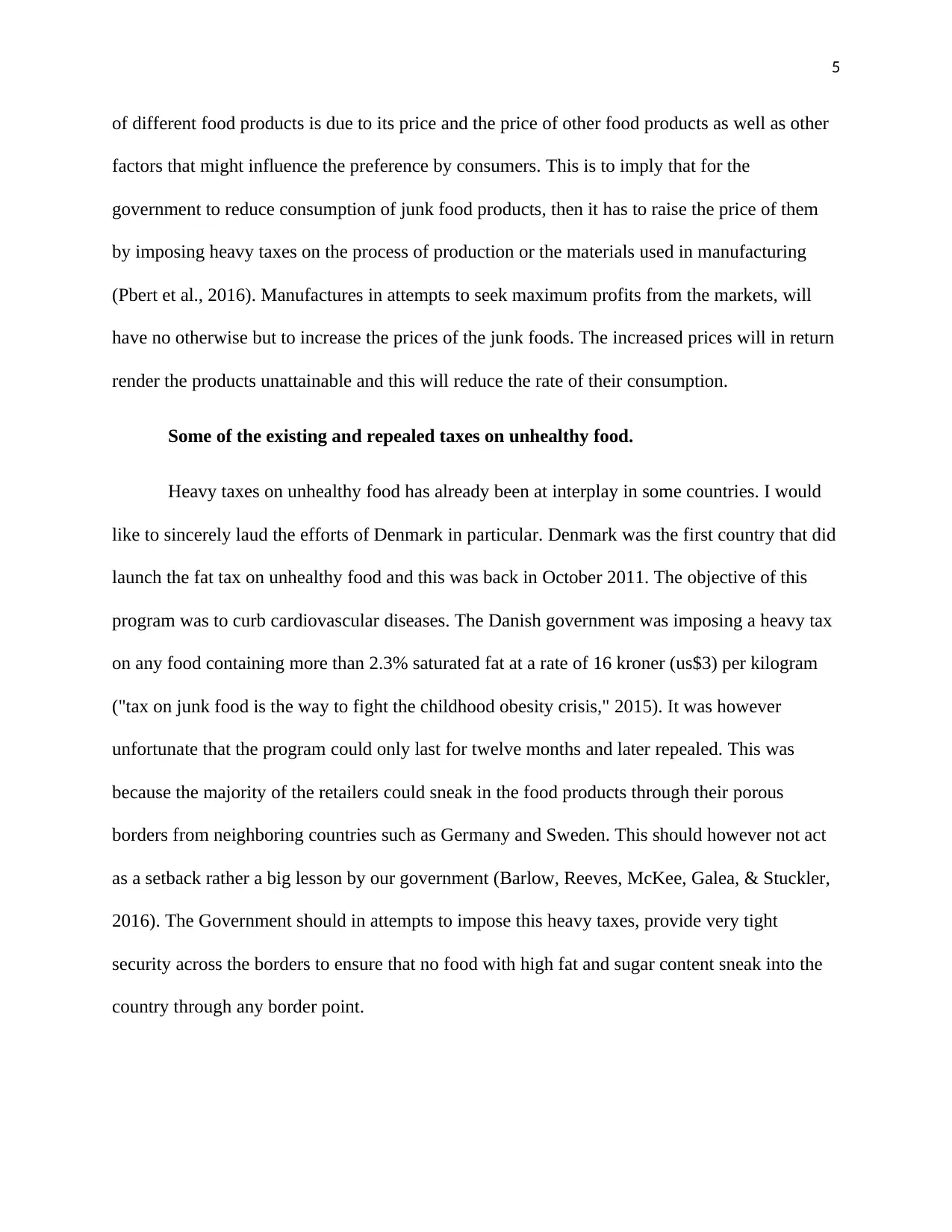
5
of different food products is due to its price and the price of other food products as well as other
factors that might influence the preference by consumers. This is to imply that for the
government to reduce consumption of junk food products, then it has to raise the price of them
by imposing heavy taxes on the process of production or the materials used in manufacturing
(Pbert et al., 2016). Manufactures in attempts to seek maximum profits from the markets, will
have no otherwise but to increase the prices of the junk foods. The increased prices will in return
render the products unattainable and this will reduce the rate of their consumption.
Some of the existing and repealed taxes on unhealthy food.
Heavy taxes on unhealthy food has already been at interplay in some countries. I would
like to sincerely laud the efforts of Denmark in particular. Denmark was the first country that did
launch the fat tax on unhealthy food and this was back in October 2011. The objective of this
program was to curb cardiovascular diseases. The Danish government was imposing a heavy tax
on any food containing more than 2.3% saturated fat at a rate of 16 kroner (us$3) per kilogram
("tax on junk food is the way to fight the childhood obesity crisis," 2015). It was however
unfortunate that the program could only last for twelve months and later repealed. This was
because the majority of the retailers could sneak in the food products through their porous
borders from neighboring countries such as Germany and Sweden. This should however not act
as a setback rather a big lesson by our government (Barlow, Reeves, McKee, Galea, & Stuckler,
2016). The Government should in attempts to impose this heavy taxes, provide very tight
security across the borders to ensure that no food with high fat and sugar content sneak into the
country through any border point.
of different food products is due to its price and the price of other food products as well as other
factors that might influence the preference by consumers. This is to imply that for the
government to reduce consumption of junk food products, then it has to raise the price of them
by imposing heavy taxes on the process of production or the materials used in manufacturing
(Pbert et al., 2016). Manufactures in attempts to seek maximum profits from the markets, will
have no otherwise but to increase the prices of the junk foods. The increased prices will in return
render the products unattainable and this will reduce the rate of their consumption.
Some of the existing and repealed taxes on unhealthy food.
Heavy taxes on unhealthy food has already been at interplay in some countries. I would
like to sincerely laud the efforts of Denmark in particular. Denmark was the first country that did
launch the fat tax on unhealthy food and this was back in October 2011. The objective of this
program was to curb cardiovascular diseases. The Danish government was imposing a heavy tax
on any food containing more than 2.3% saturated fat at a rate of 16 kroner (us$3) per kilogram
("tax on junk food is the way to fight the childhood obesity crisis," 2015). It was however
unfortunate that the program could only last for twelve months and later repealed. This was
because the majority of the retailers could sneak in the food products through their porous
borders from neighboring countries such as Germany and Sweden. This should however not act
as a setback rather a big lesson by our government (Barlow, Reeves, McKee, Galea, & Stuckler,
2016). The Government should in attempts to impose this heavy taxes, provide very tight
security across the borders to ensure that no food with high fat and sugar content sneak into the
country through any border point.
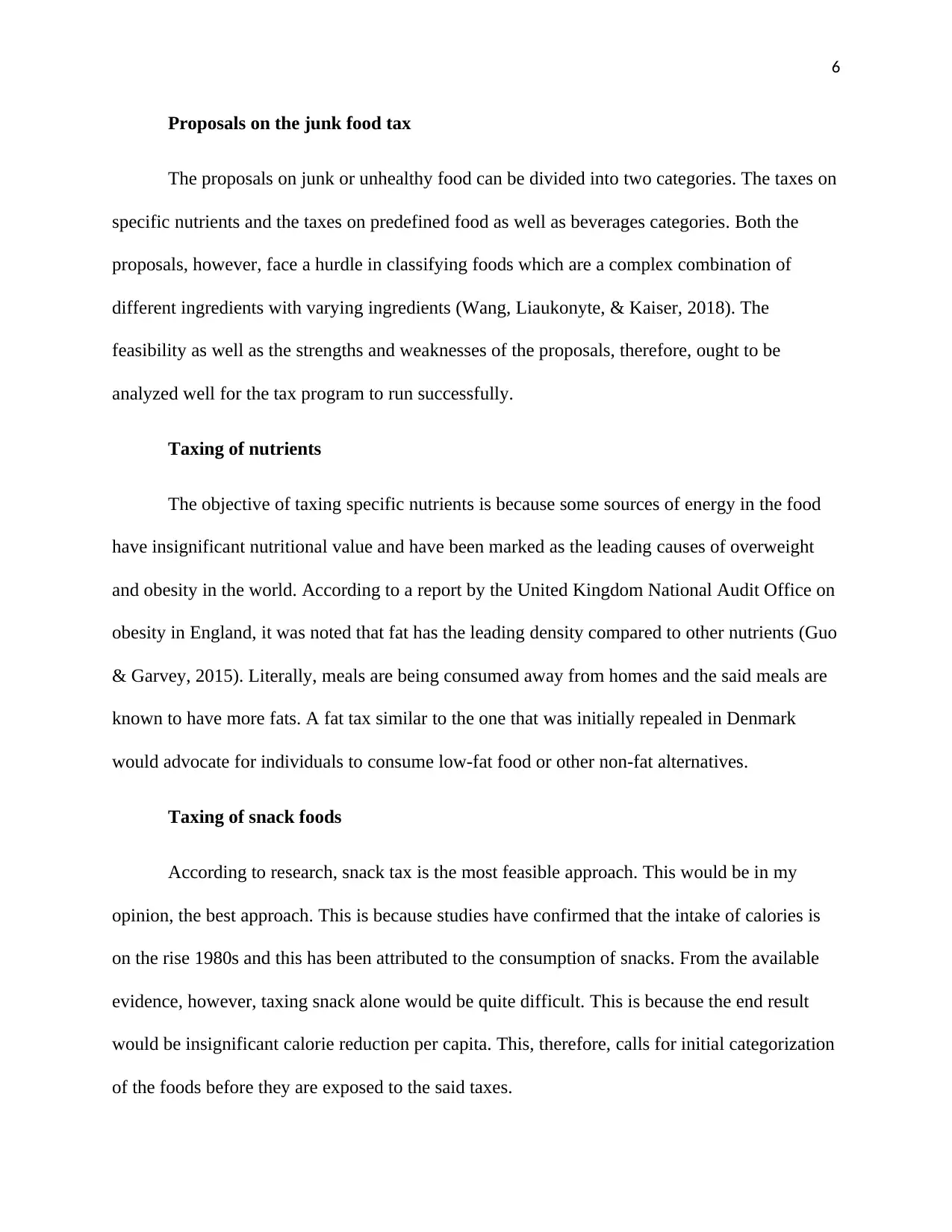
6
Proposals on the junk food tax
The proposals on junk or unhealthy food can be divided into two categories. The taxes on
specific nutrients and the taxes on predefined food as well as beverages categories. Both the
proposals, however, face a hurdle in classifying foods which are a complex combination of
different ingredients with varying ingredients (Wang, Liaukonyte, & Kaiser, 2018). The
feasibility as well as the strengths and weaknesses of the proposals, therefore, ought to be
analyzed well for the tax program to run successfully.
Taxing of nutrients
The objective of taxing specific nutrients is because some sources of energy in the food
have insignificant nutritional value and have been marked as the leading causes of overweight
and obesity in the world. According to a report by the United Kingdom National Audit Office on
obesity in England, it was noted that fat has the leading density compared to other nutrients (Guo
& Garvey, 2015). Literally, meals are being consumed away from homes and the said meals are
known to have more fats. A fat tax similar to the one that was initially repealed in Denmark
would advocate for individuals to consume low-fat food or other non-fat alternatives.
Taxing of snack foods
According to research, snack tax is the most feasible approach. This would be in my
opinion, the best approach. This is because studies have confirmed that the intake of calories is
on the rise 1980s and this has been attributed to the consumption of snacks. From the available
evidence, however, taxing snack alone would be quite difficult. This is because the end result
would be insignificant calorie reduction per capita. This, therefore, calls for initial categorization
of the foods before they are exposed to the said taxes.
Proposals on the junk food tax
The proposals on junk or unhealthy food can be divided into two categories. The taxes on
specific nutrients and the taxes on predefined food as well as beverages categories. Both the
proposals, however, face a hurdle in classifying foods which are a complex combination of
different ingredients with varying ingredients (Wang, Liaukonyte, & Kaiser, 2018). The
feasibility as well as the strengths and weaknesses of the proposals, therefore, ought to be
analyzed well for the tax program to run successfully.
Taxing of nutrients
The objective of taxing specific nutrients is because some sources of energy in the food
have insignificant nutritional value and have been marked as the leading causes of overweight
and obesity in the world. According to a report by the United Kingdom National Audit Office on
obesity in England, it was noted that fat has the leading density compared to other nutrients (Guo
& Garvey, 2015). Literally, meals are being consumed away from homes and the said meals are
known to have more fats. A fat tax similar to the one that was initially repealed in Denmark
would advocate for individuals to consume low-fat food or other non-fat alternatives.
Taxing of snack foods
According to research, snack tax is the most feasible approach. This would be in my
opinion, the best approach. This is because studies have confirmed that the intake of calories is
on the rise 1980s and this has been attributed to the consumption of snacks. From the available
evidence, however, taxing snack alone would be quite difficult. This is because the end result
would be insignificant calorie reduction per capita. This, therefore, calls for initial categorization
of the foods before they are exposed to the said taxes.
⊘ This is a preview!⊘
Do you want full access?
Subscribe today to unlock all pages.

Trusted by 1+ million students worldwide
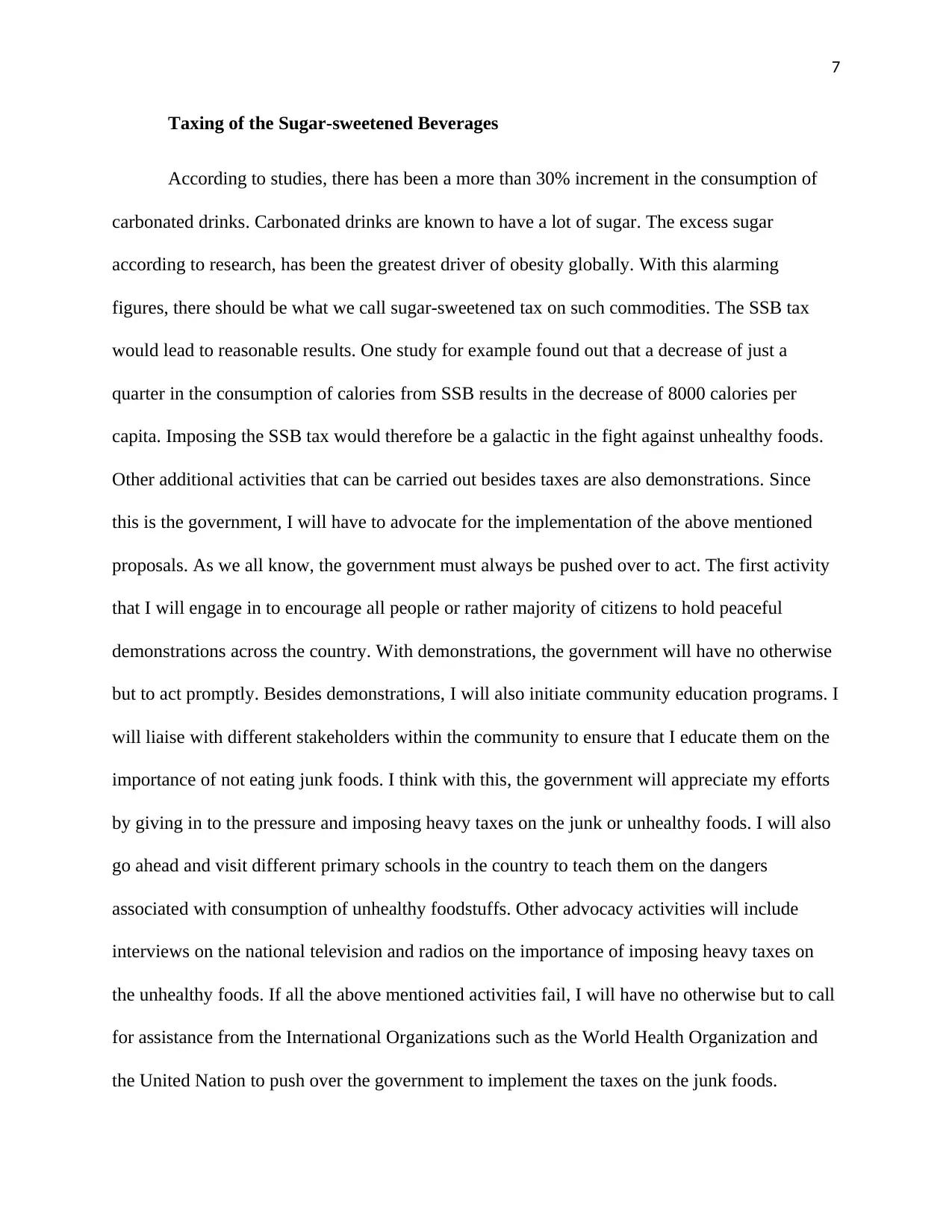
7
Taxing of the Sugar-sweetened Beverages
According to studies, there has been a more than 30% increment in the consumption of
carbonated drinks. Carbonated drinks are known to have a lot of sugar. The excess sugar
according to research, has been the greatest driver of obesity globally. With this alarming
figures, there should be what we call sugar-sweetened tax on such commodities. The SSB tax
would lead to reasonable results. One study for example found out that a decrease of just a
quarter in the consumption of calories from SSB results in the decrease of 8000 calories per
capita. Imposing the SSB tax would therefore be a galactic in the fight against unhealthy foods.
Other additional activities that can be carried out besides taxes are also demonstrations. Since
this is the government, I will have to advocate for the implementation of the above mentioned
proposals. As we all know, the government must always be pushed over to act. The first activity
that I will engage in to encourage all people or rather majority of citizens to hold peaceful
demonstrations across the country. With demonstrations, the government will have no otherwise
but to act promptly. Besides demonstrations, I will also initiate community education programs. I
will liaise with different stakeholders within the community to ensure that I educate them on the
importance of not eating junk foods. I think with this, the government will appreciate my efforts
by giving in to the pressure and imposing heavy taxes on the junk or unhealthy foods. I will also
go ahead and visit different primary schools in the country to teach them on the dangers
associated with consumption of unhealthy foodstuffs. Other advocacy activities will include
interviews on the national television and radios on the importance of imposing heavy taxes on
the unhealthy foods. If all the above mentioned activities fail, I will have no otherwise but to call
for assistance from the International Organizations such as the World Health Organization and
the United Nation to push over the government to implement the taxes on the junk foods.
Taxing of the Sugar-sweetened Beverages
According to studies, there has been a more than 30% increment in the consumption of
carbonated drinks. Carbonated drinks are known to have a lot of sugar. The excess sugar
according to research, has been the greatest driver of obesity globally. With this alarming
figures, there should be what we call sugar-sweetened tax on such commodities. The SSB tax
would lead to reasonable results. One study for example found out that a decrease of just a
quarter in the consumption of calories from SSB results in the decrease of 8000 calories per
capita. Imposing the SSB tax would therefore be a galactic in the fight against unhealthy foods.
Other additional activities that can be carried out besides taxes are also demonstrations. Since
this is the government, I will have to advocate for the implementation of the above mentioned
proposals. As we all know, the government must always be pushed over to act. The first activity
that I will engage in to encourage all people or rather majority of citizens to hold peaceful
demonstrations across the country. With demonstrations, the government will have no otherwise
but to act promptly. Besides demonstrations, I will also initiate community education programs. I
will liaise with different stakeholders within the community to ensure that I educate them on the
importance of not eating junk foods. I think with this, the government will appreciate my efforts
by giving in to the pressure and imposing heavy taxes on the junk or unhealthy foods. I will also
go ahead and visit different primary schools in the country to teach them on the dangers
associated with consumption of unhealthy foodstuffs. Other advocacy activities will include
interviews on the national television and radios on the importance of imposing heavy taxes on
the unhealthy foods. If all the above mentioned activities fail, I will have no otherwise but to call
for assistance from the International Organizations such as the World Health Organization and
the United Nation to push over the government to implement the taxes on the junk foods.
Paraphrase This Document
Need a fresh take? Get an instant paraphrase of this document with our AI Paraphraser
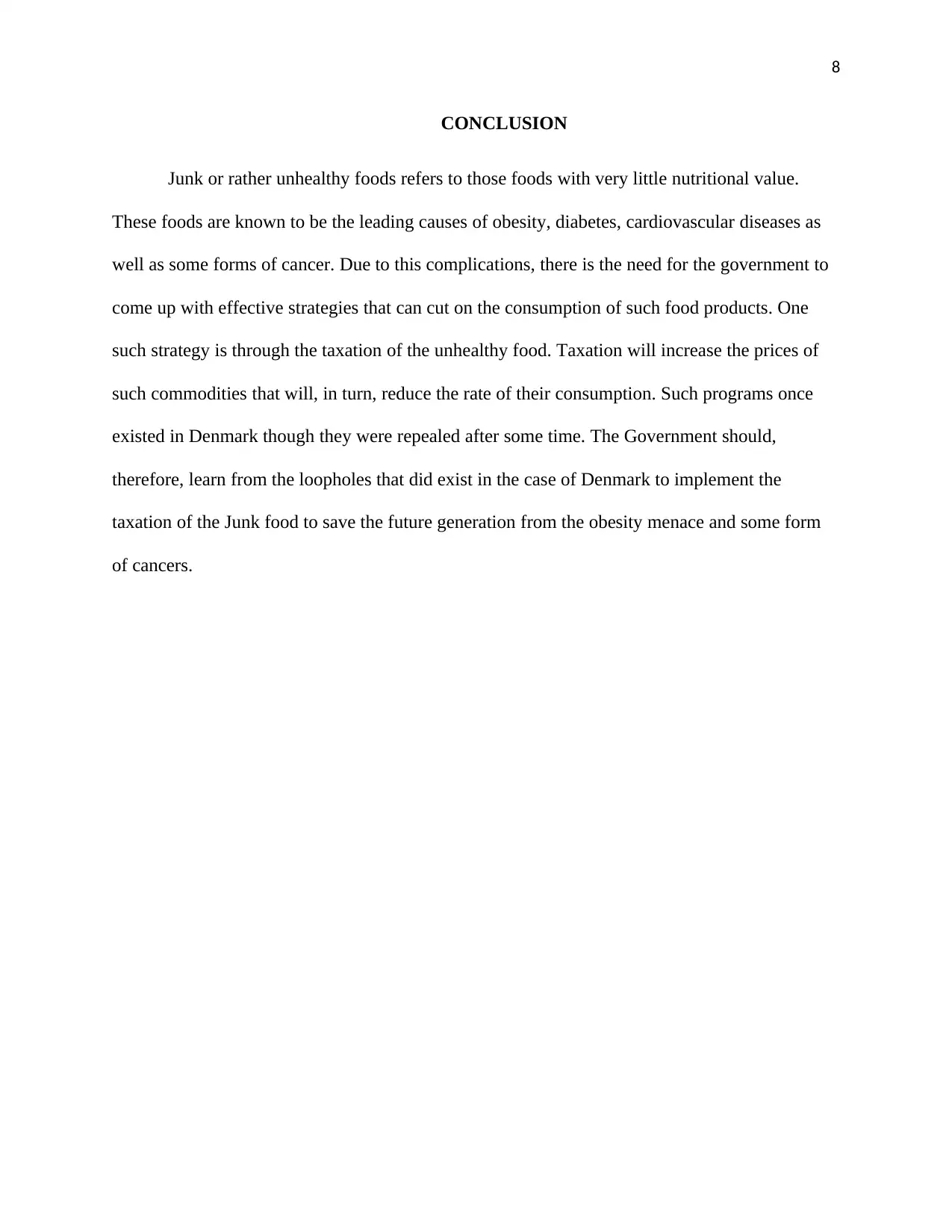
8
CONCLUSION
Junk or rather unhealthy foods refers to those foods with very little nutritional value.
These foods are known to be the leading causes of obesity, diabetes, cardiovascular diseases as
well as some forms of cancer. Due to this complications, there is the need for the government to
come up with effective strategies that can cut on the consumption of such food products. One
such strategy is through the taxation of the unhealthy food. Taxation will increase the prices of
such commodities that will, in turn, reduce the rate of their consumption. Such programs once
existed in Denmark though they were repealed after some time. The Government should,
therefore, learn from the loopholes that did exist in the case of Denmark to implement the
taxation of the Junk food to save the future generation from the obesity menace and some form
of cancers.
CONCLUSION
Junk or rather unhealthy foods refers to those foods with very little nutritional value.
These foods are known to be the leading causes of obesity, diabetes, cardiovascular diseases as
well as some forms of cancer. Due to this complications, there is the need for the government to
come up with effective strategies that can cut on the consumption of such food products. One
such strategy is through the taxation of the unhealthy food. Taxation will increase the prices of
such commodities that will, in turn, reduce the rate of their consumption. Such programs once
existed in Denmark though they were repealed after some time. The Government should,
therefore, learn from the loopholes that did exist in the case of Denmark to implement the
taxation of the Junk food to save the future generation from the obesity menace and some form
of cancers.
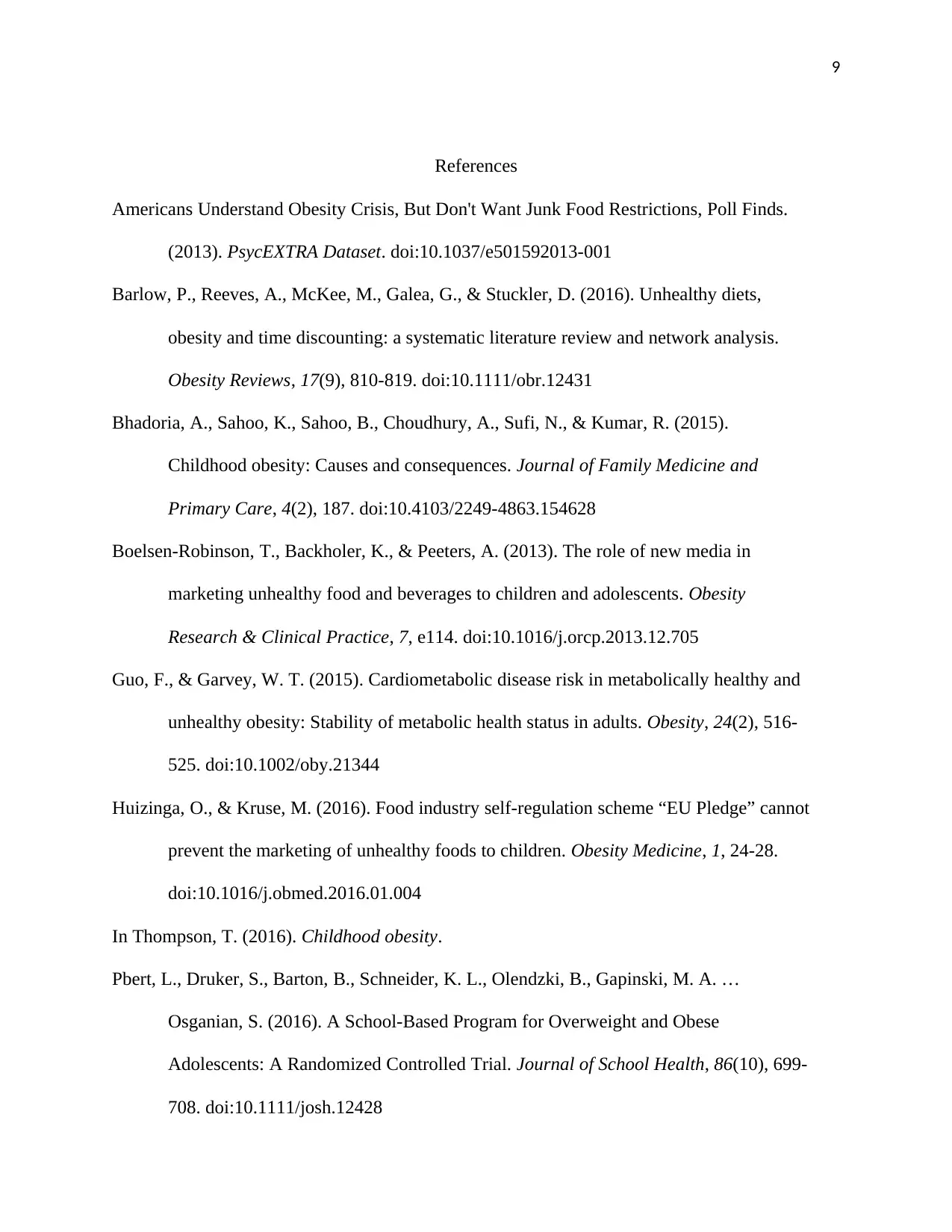
9
References
Americans Understand Obesity Crisis, But Don't Want Junk Food Restrictions, Poll Finds.
(2013). PsycEXTRA Dataset. doi:10.1037/e501592013-001
Barlow, P., Reeves, A., McKee, M., Galea, G., & Stuckler, D. (2016). Unhealthy diets,
obesity and time discounting: a systematic literature review and network analysis.
Obesity Reviews, 17(9), 810-819. doi:10.1111/obr.12431
Bhadoria, A., Sahoo, K., Sahoo, B., Choudhury, A., Sufi, N., & Kumar, R. (2015).
Childhood obesity: Causes and consequences. Journal of Family Medicine and
Primary Care, 4(2), 187. doi:10.4103/2249-4863.154628
Boelsen-Robinson, T., Backholer, K., & Peeters, A. (2013). The role of new media in
marketing unhealthy food and beverages to children and adolescents. Obesity
Research & Clinical Practice, 7, e114. doi:10.1016/j.orcp.2013.12.705
Guo, F., & Garvey, W. T. (2015). Cardiometabolic disease risk in metabolically healthy and
unhealthy obesity: Stability of metabolic health status in adults. Obesity, 24(2), 516-
525. doi:10.1002/oby.21344
Huizinga, O., & Kruse, M. (2016). Food industry self-regulation scheme “EU Pledge” cannot
prevent the marketing of unhealthy foods to children. Obesity Medicine, 1, 24-28.
doi:10.1016/j.obmed.2016.01.004
In Thompson, T. (2016). Childhood obesity.
Pbert, L., Druker, S., Barton, B., Schneider, K. L., Olendzki, B., Gapinski, M. A. …
Osganian, S. (2016). A School-Based Program for Overweight and Obese
Adolescents: A Randomized Controlled Trial. Journal of School Health, 86(10), 699-
708. doi:10.1111/josh.12428
References
Americans Understand Obesity Crisis, But Don't Want Junk Food Restrictions, Poll Finds.
(2013). PsycEXTRA Dataset. doi:10.1037/e501592013-001
Barlow, P., Reeves, A., McKee, M., Galea, G., & Stuckler, D. (2016). Unhealthy diets,
obesity and time discounting: a systematic literature review and network analysis.
Obesity Reviews, 17(9), 810-819. doi:10.1111/obr.12431
Bhadoria, A., Sahoo, K., Sahoo, B., Choudhury, A., Sufi, N., & Kumar, R. (2015).
Childhood obesity: Causes and consequences. Journal of Family Medicine and
Primary Care, 4(2), 187. doi:10.4103/2249-4863.154628
Boelsen-Robinson, T., Backholer, K., & Peeters, A. (2013). The role of new media in
marketing unhealthy food and beverages to children and adolescents. Obesity
Research & Clinical Practice, 7, e114. doi:10.1016/j.orcp.2013.12.705
Guo, F., & Garvey, W. T. (2015). Cardiometabolic disease risk in metabolically healthy and
unhealthy obesity: Stability of metabolic health status in adults. Obesity, 24(2), 516-
525. doi:10.1002/oby.21344
Huizinga, O., & Kruse, M. (2016). Food industry self-regulation scheme “EU Pledge” cannot
prevent the marketing of unhealthy foods to children. Obesity Medicine, 1, 24-28.
doi:10.1016/j.obmed.2016.01.004
In Thompson, T. (2016). Childhood obesity.
Pbert, L., Druker, S., Barton, B., Schneider, K. L., Olendzki, B., Gapinski, M. A. …
Osganian, S. (2016). A School-Based Program for Overweight and Obese
Adolescents: A Randomized Controlled Trial. Journal of School Health, 86(10), 699-
708. doi:10.1111/josh.12428
⊘ This is a preview!⊘
Do you want full access?
Subscribe today to unlock all pages.

Trusted by 1+ million students worldwide
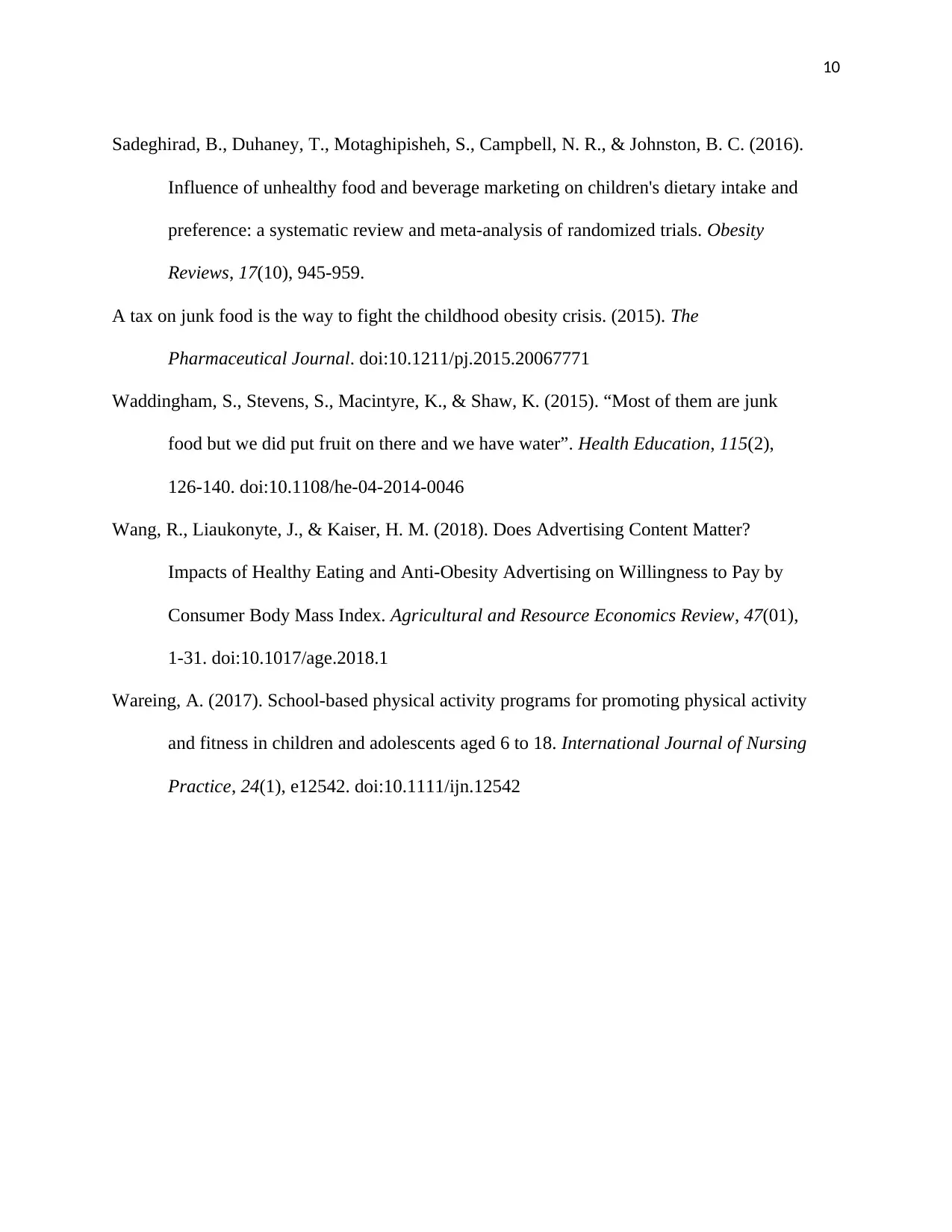
10
Sadeghirad, B., Duhaney, T., Motaghipisheh, S., Campbell, N. R., & Johnston, B. C. (2016).
Influence of unhealthy food and beverage marketing on children's dietary intake and
preference: a systematic review and meta-analysis of randomized trials. Obesity
Reviews, 17(10), 945-959.
A tax on junk food is the way to fight the childhood obesity crisis. (2015). The
Pharmaceutical Journal. doi:10.1211/pj.2015.20067771
Waddingham, S., Stevens, S., Macintyre, K., & Shaw, K. (2015). “Most of them are junk
food but we did put fruit on there and we have water”. Health Education, 115(2),
126-140. doi:10.1108/he-04-2014-0046
Wang, R., Liaukonyte, J., & Kaiser, H. M. (2018). Does Advertising Content Matter?
Impacts of Healthy Eating and Anti-Obesity Advertising on Willingness to Pay by
Consumer Body Mass Index. Agricultural and Resource Economics Review, 47(01),
1-31. doi:10.1017/age.2018.1
Wareing, A. (2017). School-based physical activity programs for promoting physical activity
and fitness in children and adolescents aged 6 to 18. International Journal of Nursing
Practice, 24(1), e12542. doi:10.1111/ijn.12542
Sadeghirad, B., Duhaney, T., Motaghipisheh, S., Campbell, N. R., & Johnston, B. C. (2016).
Influence of unhealthy food and beverage marketing on children's dietary intake and
preference: a systematic review and meta-analysis of randomized trials. Obesity
Reviews, 17(10), 945-959.
A tax on junk food is the way to fight the childhood obesity crisis. (2015). The
Pharmaceutical Journal. doi:10.1211/pj.2015.20067771
Waddingham, S., Stevens, S., Macintyre, K., & Shaw, K. (2015). “Most of them are junk
food but we did put fruit on there and we have water”. Health Education, 115(2),
126-140. doi:10.1108/he-04-2014-0046
Wang, R., Liaukonyte, J., & Kaiser, H. M. (2018). Does Advertising Content Matter?
Impacts of Healthy Eating and Anti-Obesity Advertising on Willingness to Pay by
Consumer Body Mass Index. Agricultural and Resource Economics Review, 47(01),
1-31. doi:10.1017/age.2018.1
Wareing, A. (2017). School-based physical activity programs for promoting physical activity
and fitness in children and adolescents aged 6 to 18. International Journal of Nursing
Practice, 24(1), e12542. doi:10.1111/ijn.12542
1 out of 10
Related Documents
Your All-in-One AI-Powered Toolkit for Academic Success.
+13062052269
info@desklib.com
Available 24*7 on WhatsApp / Email
![[object Object]](/_next/static/media/star-bottom.7253800d.svg)
Unlock your academic potential
Copyright © 2020–2025 A2Z Services. All Rights Reserved. Developed and managed by ZUCOL.





